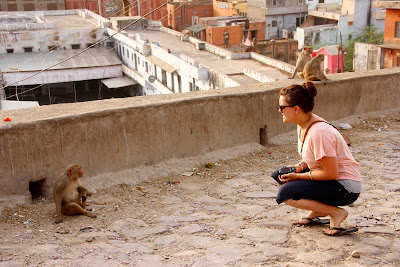The hilltop town of Mcleod Ganj is one of the most picturesque and fascinating places we have seen during our travels through India, with its raging rivers deep in the valleys to the snow-capped Himalayas which tower from above.
McLeod Ganj is situated in the Himalayan foot hills north of the main city centre of Dharamsala. This town is quite unique as it offers both an Indian and Tibetan experience with hundreds of Tibetan refugees having fled from their country in the late ‘40s in an endeavour to escape Chinese persecution. Colourful Tibetan prayer flags are hung from the cliff tops, store fronts and rooftops providing blessings to the town and the people living there.
The air is crisp and fresh, with the smell of Tibetan momos now replacing the rich aromas of Indian spices. Despite the fact that we are still in India, you could easily be mistaken for being in Tibet, with shaven-headed monks walking the streets towards the Dalai Lama’s residency and the Indian presence now close to non-existent.
Deep and I spent close to a week exploring the hill tops, winding roads and alleyways of this town, as well as the surrounding villages. We spent an entire day uncovering the Buddhist philosophy by visiting Tibetan villages, monasteries and the Dalai Lama’s residence. Unfortunately we missed seeing him by only a few days. We also got the opportunity to explore the school where Deep went for a year when he was eight years old.
But none of these experiences compare to our adventure in the forest, a few kilometres out of a small village called Nadi. We decided on our last day in Mcleod Ganj to go for a walk to the river just below Deep’s old school. We began our journey just after lunch with our picnic bag and rug in hand. After a gruelling two-and-a-half hour trek through dense forest and a steep dirt track we made it to the river.
As the sun began to set we both came up with the bright idea that it would be a lot quicker to follow the river upstream than to walk back the way we came. At first it began as an exciting adventure, clambering over large boulders, making bridges across the raging river with rocks and tree branches. Though the further we went the more strenuous and dangerous the trek became. In some sections the river was moving too fast for us to cross so we had to trek up the side of the mountain on all fours.
It wasn’t until we could see the sun slipping from the sky that we started to realise we were running out of time in the race against the light. I tried to climb a large rock to get up the mountain side though I slipped and came crashing down into the water. When I look back now I can’t help but laugh at my stupidity, though at the time, falling into that freezing cold water was quite scary. Luckily Deep had a spare jumper in his bag which was quickly replaced by my soaking wet top. We decided to give up on following the river and head up the mountain side.
I’m not trying to be all Bear Grylls here, but there was no track to follow, nothing to cling on to, just a sheer cliff face and a decreasing amount of day light. Half way up the mountain we saw the lights of the hotel on the main road and we began to feel a lot more confident that we were almost there. However by this point we had completely run out of all day light and began the difficult task of blindly making our way to the top.
After hobbling on a sore knee and being cut from head to toe by tawny bushes, we finally made it to the main road. I have to say, I have never been so scared in my life and am extremely grateful to my amazing partner Deep who step-by-step helped me up the mountain, staying positive the entire way. I didn’t think I would have quite the adventure that Deep and I had that day, but the funny thing is we both said we wouldn’t take back the experience. Bring on Everest I say. (Just a little note to my parents, please don’t worry, next time we go on a trek, we will take an experienced guide with us).
By Kerryn Anker




















































